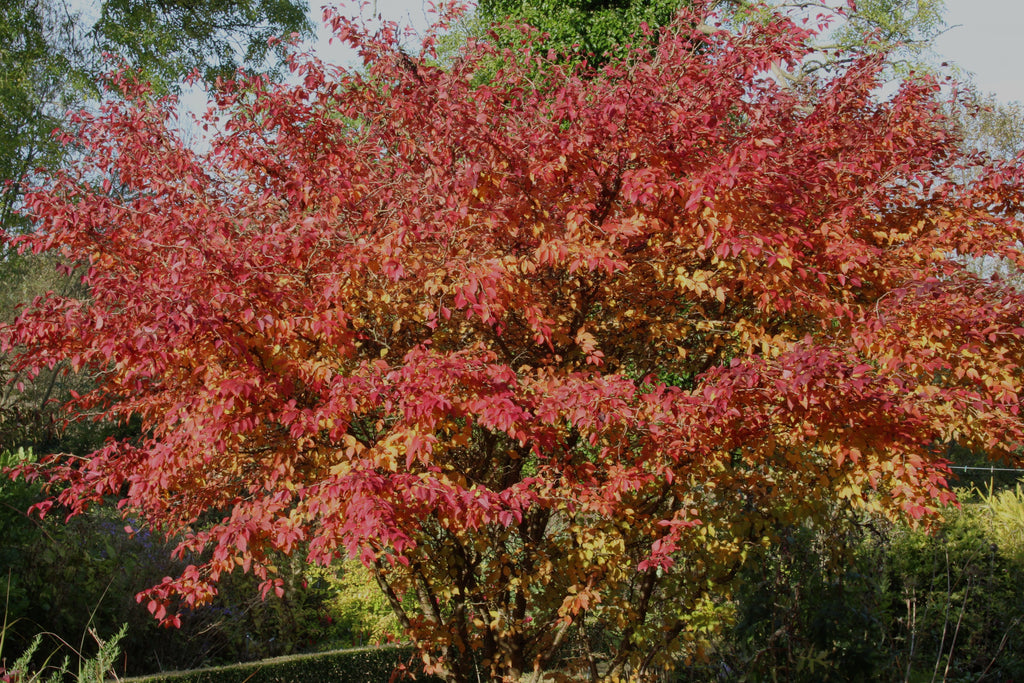
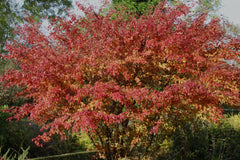



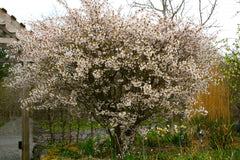

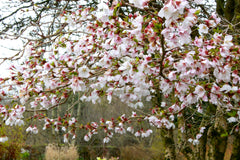
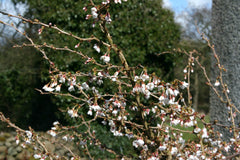
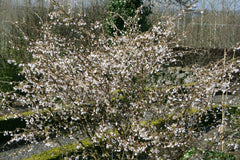
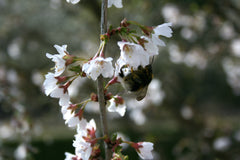
About this cultivar:
Prunus incisa 'Kojo-no-mai' is a great plant, maybe an all time great. Paul, you say, you have thousands of plants on this website so that is a bold claim. Why?
It looks different, yet beautiful, every season. The bloom in early spring is wonderful, the small leaves in summer give a warm, soft, bushy effect, the autumn colour is, well, look at the photos, and the structure in winter is intricately unusual, like a miniature tree (ok, ok, I need a photo).
It seems to grow well everywhere, damp, dry, sun, shade, and...in pots....
Despite it's 'eventual' height being reasonably large you can also grow it much smaller if you keep it in a pot. I think many people do this for Bonsai. If you look at our photo (albeit a bad photo) with one in a blue pot and one in the ground, both plants are the same age yet the pot grown plant is smaller! (Also note, by way of education you guys, plants in pots flower earlier and go dormant earlier. Look at the difference in foliage in the pot photo. I know you still won't believe me.....but I am right [I am always right by the way]).
Has the Royal Horticultural Society Award of Garden Merit (RHS AGM). I believe the name translates as 'Butterfly', a nod to the transitions?
- Position: Full sun, partial shade
- Soil: Almost any soil, grows well in Ballyrobert
- Flowers: March, April
- Other features: Royal Horticultural Society Award of Garden Merit (RHS AGM), Grows well in Ballyrobert
- Hardiness: Fully hardy, grows well in Ballyrobert, H6 - Hardy in all of UK and northern Europe (-20 to -15°C)
- Habit: Clump forming, bushy
- Foliage: Deciduous
- Height: 150 - 250 cm (5 - 8.2 ft)
- Spread: 150 - 250 cm (5 - 8.2 ft)
- Time to full growth: 20 to 50 years
- Plant type: Herbaceous Perennial, shrub, tree
- Colour: Green, purple, red, white
- Goes well with: -
About this genus:
Prunus is a large genus of trees and shrubs containing over 400 different species. Native to northern temperate regions the genus includes plums, damsons, cherries, peaches, nectarines, apricots, and almonds. Many more Prunus are also cultivated as ornamental plants, usually for their profusion of flowers, ornamental foliage, ornamental habit, and occasionally for their bark.
The earliest known fossil specimens are wood, fruit, seed, and even a leaf from the middle Eocene Period (33-56 million years ago) found in British Columbia. It was first described more recently, in 1737, when Carl Linnaeus classified Amygdalus, Cerasus, Prunus, and Padus as separate genus. Since then they have become species of Prunus. He took the name from the Latin, Prunus, which was in turn a borrowed word from Greek.
Linnaeus wasn’t the only one to get genus and species confused when talking about Prunus. The cofounder of the American Society for Horticultural Science, Liberty Hyde Bailey (1858-1954), mentioned ‘The numerous forms grade into each other so imperceptibly and inextricably that the genus cannot be readily broken up into species.’ I am sure DNA research will soon lay waste to this thinking, but for now Prunus is currently a large genus within the rose family Rosaceae, so let’s leave it at that!
Members of the genus can be evergreen or deciduous, some species offer beautiful autumn colour. In general the leaves are simple, alternate on the stem, lanceolate, and unlobed. Usually coming in spring or early summer the flowers can be white to pink, sometimes red, with five petals and five sepals. The flowers are borne singly, or in umbels of two to six, or sometimes on racemes. The fruit is a fleshy drupe (aka prune) with a single relatively large, hard-coated seed (aka stone).
When talking about growing Prunus in the garden we have to be vague because it is such a large and varied genus. However, since they are quite ubiquitous that should give you confidence they are easy to grow in most locations. They are usually grown as small specimen trees on their own since they can offer four seasons of interest; blossom, then foliage, then autumn colour, then winter structure. However, don’t be afraid to mix them up in borders.

